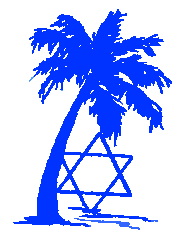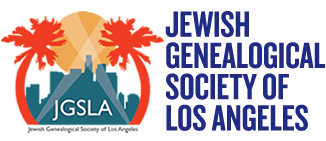December 2006
 |
JGSLA DATES AND UPDATESJEWISH GENEALOGICAL SOCIETY of LOS ANGELES December 2006 |
|
· Program for Monday, December 11, 2006 · |
|
|
There are Tears in Things: Remembering and Retelling the Holocaust Daniel Mendelsohn discusses The Lost: A Search for Six of Six Million The Lost is much more than a book about the Holocaust. It is about rescuing the stories of the Holocaust and re-imagining the lives of those who perished so they are no longer lost to history. Spurred by a cache of desperate letters written to his grandfather in 1939 by his great-uncle, Shmiel Jäger, Daniel Mendelsohn’s “strange and arduous” journey to solve the mystery of this family began in 2001 when he returned to his ancestral shtetl of Bolechow. For 300 years the Jägers had lived in this Galician village, which was first part of the Austro-Hungarian Empire, then Poland, Germany, Russia and today Ukraine. Although Shmiel’s siblings made it out before the war, Shmiel stayed behind and was killed along with his wife, Ester, and their four daughters. Haunted from an early age by the mute European faces staring out at him from pictures in his family’s “ancient leather photo albums,” Mendelsohn embarked, in middle age, on a hunt for the remaining eyewitnesses to the events of that awful time. This pilgrimage, lasting more than three years, took him to a dozen countries on three continents where he interviewed the last remaining Bolechower survivors – most in their 90s – who shared all they remembered about the Jägers, not only how they died, but how they lived. Part memoir, part reportage, part mystery and part scholarly detective work, The Lost brilliantly explores the nature of time and memory, family and history. It also aims to awaken individual-scale anguish about the Holocaust by illuminating the smallest of stories—the private life and tragic fate of one single family. Expressing how the Holocaust continues to affect people who had no direct experience of it, Mendelsohn, the classicist, expands on Virgil’s text: “There are tears in things; but we all cry for different reasons.” Join us as Mendelsohn recounts this astonishing journey to rescue from “generalities, symbols, and abbreviations,” the family, who, like so many of our own vanished ancestors, were “calling out to be known.” Please visit our website www.jgsla.org for links to book reviews and further information. DANIEL MENDELSOHN is an award-winning author, journalist, and critic, educated at the University of Virginia and at Princeton. After completing his Ph.D. in Classics in 1994, he began a career in journalism in New York City, and since then his articles, essays, reviews and translations have appeared frequently in numerous national publications, including The New Yorker, The New York Times, New York, The New York Review of Books, Esquire, and Travel & Leisure, where he is a contributing editor. From 2000 to 2002, he was the weekly book critic for New York Magazine, for which he won the National Book Critics Circle Award for Excellence in Criticism. He is the faculty chair of humanities at Bard College. ELECTIONS for the JGSLA BOARD OF DIRECTORS will take place at the beginning of our meeting. Nominations from the floor will be held at our November 16th meeting, and the list of nominees will be sent to members via email prior to the election on December 11th. LOCATION: Skirball Cultural Center, Magnin Auditorium 2701 N. Sepulveda Blvd. Exit the San Diego Fwy. at Skirball Center Dr. Turn right onto Sepulveda Blvd. and right again into Skirball parking, opposite the Center entrance, or turn left on Herscher Drive, north of the Center, to the underground parking lot. Free for JGSLA members, $5 for guests. Non-members are invited to join ($25 annual dues). Parking is free. |
|
JGSLA Welcomes the Following New Members
Renew Your Membership by Dec 31st As the JGSLA is a 501(c) (3) charitable organization, your dues may be tax deductible. Check with your tax preparer. Unique Chanukah Gift Consider giving a membership in the JGSLA. For a nominal cost, the recipient will receive our award winning journal, Roots-Key for a full year, be invited to informative meetings throughout the year, and be able to participate in the many projects and activities that make the JGSLA a very special organization. Give the gift of discovering oneself by discovering one’s family history. Member News Our thoughts are with members Don and Sally Goodman. Their daughter, Lesley, recently had emergency spinal surgery. Also, Don passed out while swimming and nearly drowned. He had a pacemaker implanted, and should be back swimming and hiking by year-end. Maintaining Mt. Zion Cemetery Mount Zion Cemetery, established in 1916 by the Jewish Free Burial Society, is located at 1030 S. Downey Road, adjacent to the Home of Peace Cemetery in East Los Angeles. It was not connected to a synagogue and unfortunately fell into disrepair over the years. The Jewish Federation Council [www.jewishla.org] now operates Mt. Zion Cemetery, which has no endowment fund. Each year the Federation appeals to its member organizations for contributions to maintain and repair the cemetery. If you have family and friends of family buried at Mt. Zion, or would like to help maintain one of our oldest landmarks, please consider a contribution at this time. JGSLA will match the first $100 received for Mt. Zion Cemetery. Make a notation that the donation is for Mt. Zion, and mail your contribution to: JGSLA, PO Box 55443, Sherman Oaks, CA 91413. Southern U.S. Jewish Genealogy For those researching ancestors in the South, the Institute for Southern Jewish Life launched a digital archive project that will include a history of every congregation and every significant Jewish community in a 12-state region. The first state to be put online is Mississippi. Please refer to: [www.isjl.org/history/archive/]. |
Canadian Genealogical Research Canadian Passenger Lists 1865-1922 Now Online Library and Archives Canada has placed online passenger lists for 1865-1922. The site includes images only; there is no passenger index. For a description of the collection see [www.collectionscanada.ca/archivianet/passenger]. Canadian Passenger Ship Index Database The Nanaimo Family History Society has created a Canadian Passenger ship index database that currently contains records for the years 1908 to 1910. They plan on expanding their index to include all Canadian ports for the years 1900 to 1924. See [members.shaw.ca/nanaimo.fhs]. St. Albans records If your relative crossed the border from Canada to the U.S., they may be found in the St. Albans border crossing records. These are available at the LDS Regional Family History Center. This may then provide you with the name of the ship and date of arrival. You can use this to go directly to the actual online passenger list. Other ways to proceed The Library and Archives Canada website suggest the following for finding the year of arrival, which may help in isolating a passenger list: 1911 Canadian Census The most recently available Canadian census is the one for 1911. While this census is available online, it is not indexed. So, you will need to start with a rough idea of the individual’s location. An exact address would, of course, be best. If you don’t have the address, check city directories. You can access the Census at: Canadian Genealogy Centre For more information about pursuing your Canadian research, check out the following Library and Archives Canada website: [www.collectionscanada.ca/genealogy]. |
|
Resources for Canadian Research The following site contains a wide range of links to Sources for Genealogical Research in Canada: [www3.sympatico.ca/bkinnon/cangenealogy.htm] Success Story – Moldova On a recent trip to Moldova, the birthplace of my husband’s grandparents, we went to the local cemetery. I handed a translated list of names to two women who only spoke Russian. After about ten minutes they had us follow them and pointed to the grave of my husband’s great-grandfather. The marker had been destroyed but the name was clear. They then pointed to the grave of my husband’s great-grandmother. We were awestruck. British Royal Naval Seamen The British National Archives provides online registers of more than 500,000 Royal Naval seamen. So, if your relative served in the British Navy, you may want to check [www.nationalarchives.gov.uk/documentsonline]. While it is highly unlikely the Domesday book (a survey of property across England conducted by William the Conqueror in 1085) will be helpful in your genealogical research, you may find scanning it interesting nonetheless. It can also be accessed at the above website. Early Jewish Families of Los Angeles If you are interested in the early Jews of Los Angeles, please check out my first cousin Linda Levi’s website, [homepage.mac.com/lindalevi/Personal/Menu42.html]. She has done an excellent job of assembling information and photographs related to early Los Angeles history and the Newmark and Levi families and associated families (meaning most Jewish families that have been in Los Angeles for a long time). Newmark descendants married into many early Los Angeles Jewish families including the Loebs, Loews, Nordlingers, etc. Newmark relatives include: Katharine Graham, former publisher of the Washington Post; Senator Barry Goldwater; Kaspare Cohn, founder of the predecessor of Cedars/Sinai Medical Center and Union Bank; and clothing merchant Levi Strauss. Linda Levi is a professional artist (a retired Professor of Art at Cerritos College), and the main part of her site [LindaLevi.net] includes a section where she has married old photographs with later images of people and pets (mostly cats). |
Improvements to FamilySearch.org From Nu, What’s New [www.avotaynu.com]The Mormon Church has plans to make major improvements to their primary genealogy site, [www.FamilySearch.org]. The current site contains the catalog of the Family History Library and databases that identify individuals, including Ancestral File, Pedigree Resource File, Social Security Death Index and certain census and vital records indexes. It also includes the International Genealogical Index, which is their religious index that identifies people to whom Mormon rituals, such as posthumous baptism, have been performed.Future plans call for the ability to post family trees to the site. As described, it appears to be similar to [OneGreatFamily.com] which permits family trees to be merged and independent people to post information to a tree if they disagree with its content. For example, there may be a question as to the birth date of a person. Additional information can be found in a news article that appeared in the Salt Lake City Deseret News at [deseretnews.com/dn/view/0,1249,650194998,00.html]. Historical New York Times Do you have a home subscription to The New York Times? If so, then you qualify to get free access to ProQuest’s Historical NY Times database from your home computer. (If you are not a newspaper subscriber, this access is available for less than 14 cents a day.) You are permitted to download up to 100 articles per month (1851-2003). See: [www.nytimes.com/products/timesselect/hd]. NYC Property records online, 1966-present “ACRIS” is an online city register where you can search property records for Manhattan, Queens, Bronx and Brooklyn dating back to 1966. It offers internet access to real and personal property documents (deeds, mortgages, real estate transfer taxes) filed with the City Register, with the ability to search indices, view document images, and print data or scanned images. You can access it at: www.nyc.gov/html/dof/html/jump/acris.shtml] 1883 Map of the German Empire Share Your Hints and News Please let us know of major family events, brief research stories, exciting research successes and research hints so that they can be shared in Dates & Updates. Send your input to Hal Bookbinder, D&U Editor [hal@jgsla.org]. |
